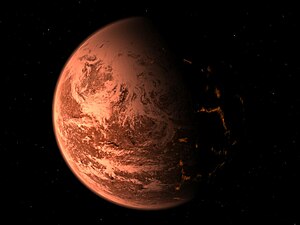Gliese 876 d
| Exoplanet | List of exoplanets | |
|---|---|---|
 |
||
| Parent star | ||
| Star | Gliese 876 | |
| Constellation | Aquarius | |
| Right ascension | (α) | 22h 53m 16.73s |
| Declination | (δ) | −14° 15′ 49.3″ |
| Apparent magnitude | (mV) | 10.17 |
| Distance | 15.3 ly (4.72 pc) |
|
| Spectral type | M4V | |
| Mass | (m) | 0.334 (± 0.030) M☉ |
| Radius | (r) | 0.36 R☉ |
| Temperature | (T) | 3350 (± 300) K |
| Metallicity | [Fe/H] | 0.05 (± 0.20) |
| Age | 2.55 (± 2.45) Gyr | |
| Physical characteristics | ||
| Mass | (m) | 6.83 (± 0.40) M⊕ |
| Radius | (r) | ~1.65 R⊕ |
| Stellar flux | (F⊙) | 30.03 ⊕ |
| Temperature | (T) | 614 K (341 °C; 646 °F) |
|
Orbital elements Epoch HJD 2,450,602.093 |
||
| Semi-major axis | (a) | 0.02080665 (± 0.00000015)AU |
| Eccentricity | (e) | 0.207 (± 0.055) |
| Orbital period | (P) | 1.937780 (± 0.000020)d |
| Inclination | (i) | 59° |
| Argument of periastron |
(ω) | 234 ± 20 ° |
| Mean anomaly | (M) | 355 ± 19 ° |
| Semi-amplitude | (K) | 6.56 ± 0.37 m/s |
| Discovery information | ||
| Discovery date | June 13, 2005 | |
| Discoverer(s) | Rivera et al. | |
| Discovery method | Doppler spectroscopy | |
| Discovery site | California and Carnegie Planet Search |
|
| Discovery status | Published | |
| Database references | ||
| Extrasolar Planets Encyclopaedia |
data | |
| SIMBAD | data | |
| Exoplanet Archive | data | |
| Open Exoplanet Catalogue | data | |
Gliese 876 d is an exoplanet approximately 15 light-years away in the constellation of Aquarius. The planet was the third planet discovered orbiting the red dwarf Gliese 876. At the time of its discovery, the planet had the lowest mass of any known extrasolar planet apart from the pulsar planets orbiting PSR B1257+12. Due to this low mass, it can be categorized as a super-Earth.
The mass of Gliese 876 d from radial velocity has one problem, it is that only a lower limit on the mass can be obtained. This is because the measured mass value also depends on the orbital inclination, which in general is unknown. However, models incorporating the gravitational interactions between the resonant outer planets enables the inclination of the orbits to be determined. This reveals that the outer planets are nearly coplanar with an inclination of around 59° with respect to the plane of the sky. Assuming that Gliese 876 d orbits in the same plane as the other planets, the true mass of the planet is revealed to be 6.83 times the mass of Earth.
The low mass of the planet has led to suggestions that it may be a terrestrial planet. This type of massive terrestrial planet could be formed in the inner part of the Gliese 876 system from material pushed towards the star by the inward migration of the gas giants.
Alternatively the planet could have formed further from Gliese 876, as a gas giant, and migrated inwards with the other gas giants. This would result in a composition richer in volatile substances, such as water. As it arrived in range, the star would have blown off the planet's hydrogen layer via coronal mass ejection. In this model, the planet would have a pressurised ocean of water (in the form of a supercritical fluid) separated from the silicate core by a layer of ice kept frozen by the high pressures in the planetary interior. Such a planet would have an atmosphere containing water vapor and free oxygen produced by the breakdown of water by ultraviolet radiation.
...
Wikipedia
